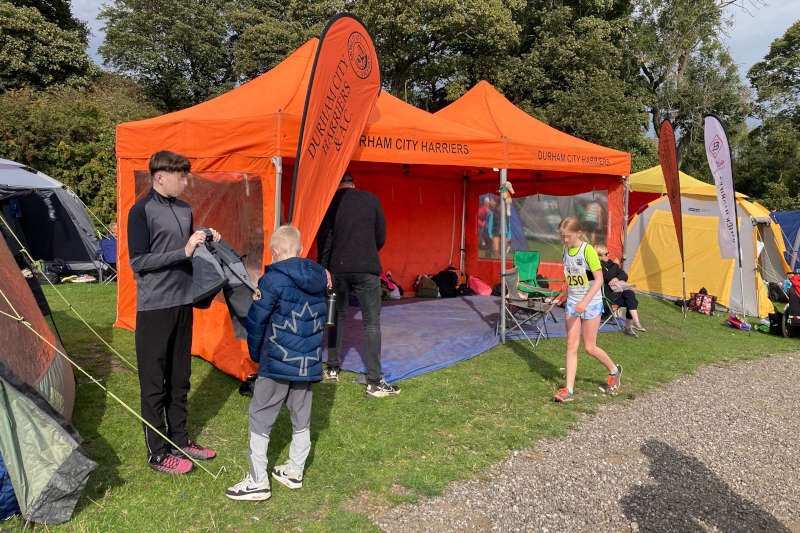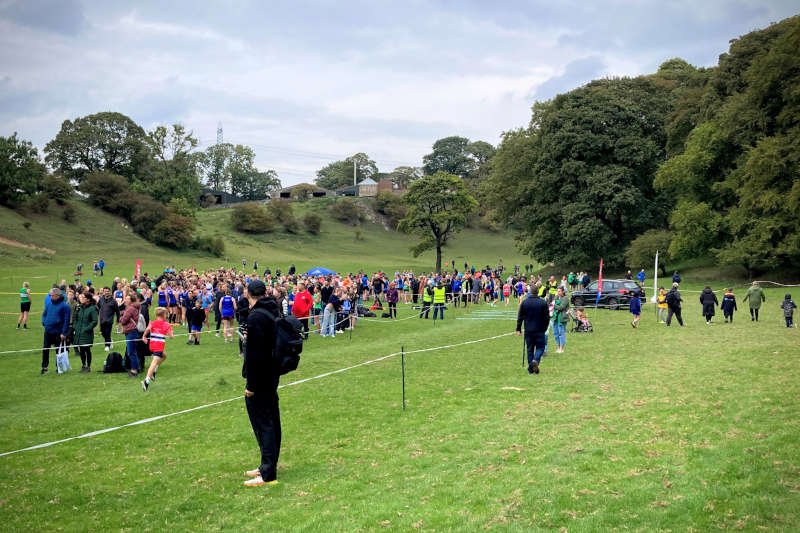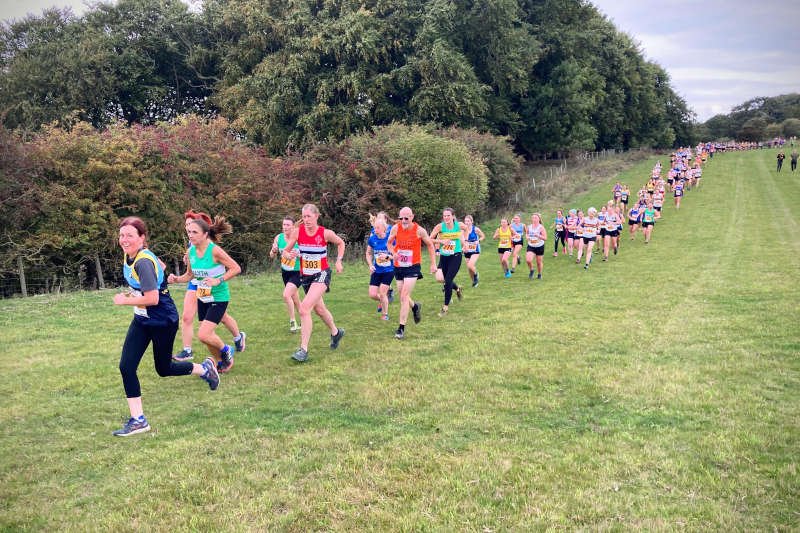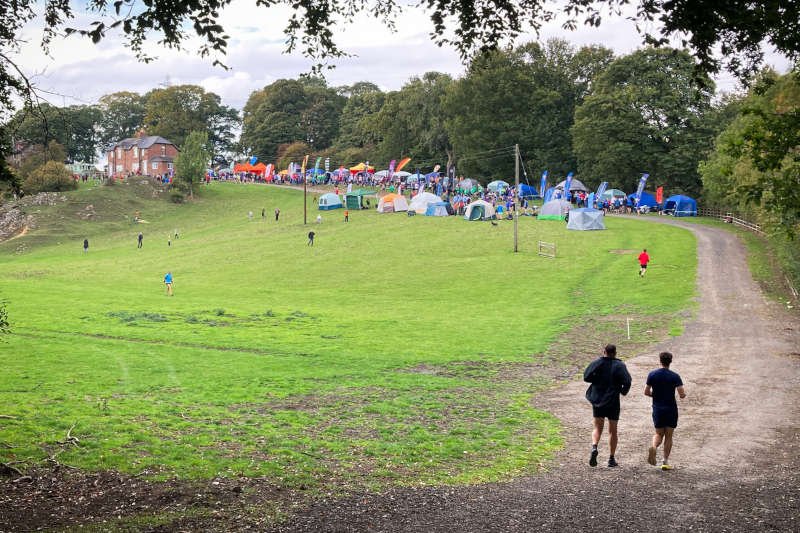Saturday 27th September 2025 | Not only was this to be my first Start Fitness North East Harrier League cross-country race for a few years, it was also my first “proper” race in a year that’s reached its final quarter. What’s more, it would be my first outing in the bright orange vest of my new club, Durham City Harriers.
That morning I woke with an all-too-familiar feeling: a deep reluctance to subject myself to the painful intensity of a race, even one still a few hours away. Being the closest of all the fixtures however, and with a forecast for warm sunshine, there was nothing to support a decision to cry off. “If I get this one under my belt” — I reminded myself — “I can defer being a DNS (“Did Not Start”) until I really need it, when winter takes hold and conditions are properly cold and miserable”. I like to think I’m joking but such thoughts are hard to shake off when the winter rain is lashing against a warm sitting-room window.
Another familiar trope helping to erode my resolve was doubt about my race fitness. Recently I’d been doing a bit more cycling than running, with speed work being the main casualty. Deep down however, I knew that my general fitness was decent and that it wouldn’t do as an excuse. Honestly, you’d think I didn’t want to take part — the club even pays the entry.
As ever though, the doubts subsided and I dropped easily into the old routine — it felt like I’d never been away. Working backwards from the 1:50 pm race start, I’d need to leave the house by 12:30 pm. I changed into my race kit, attaching a link of four safety-pins to my, as yet unblemished, bright-orange vest, ready to secure the race number which I’d keep for the season. Underneath that, as ever, was the chest strap for my heart rate monitor.
Although I wouldn’t need them today, I still donned warm, weather-proof layers because that’s my habit and I know I’ve got everything. I then spent a few unanticipated moments hunting for my race shoes (fell shoes rather than spikes — as always) while slipping into a pair of practical “crocs” for the journey. After a last-minute visit to the loo I left the house on time, picking up a bottle of water, a flask of coffee and a light duffel-bag in which I could stow my clothes prior to the race.
The drive across Durham was swift and the organisation on arrival — courtesy of Blackhill Bounders — smooth. Such is the scale of Harrier League events that, from my parking spot in the furthest corner of the field, it took a full ten minutes to reach the panoply of brightly coloured tents. For those that don’t know, a cross-country event looks rather like a medieval tournament. A small village of bannered club tents, emblazoned with the names of the clubs to which they belong, offer a modicum of shelter for their athletes on days when the weather is the main competitor.

One unexpected advantage of having joined Durham City Harriers is that their bright orange tent is easily the most obvious I’ve ever had to locate. On this occasion it was almost the closest.
After receiving the all-important race-number from Phil, the club’s cross-country captain, I set off for a slow warm-up while familiarising myself with the course. My preference, unlike most runners, I think, is to do this in the opposite direction to which the race is run. I think you see more things more quickly, it helps me keep an eye on what’s approaching and encourages me to stop and check out obstacles with a bit more focus.
Since I last competed I’d moved into the Vet60 category. On the positive side, getting older means that one’s direct competition is gradually whittled away (you gain places just by staying in the game). Trying to work out who might be the competition would offer an interesting distraction in the first race of my campaign.
Watching the huge field of ladies come past in their race (the one prior to mine) helped get the juices flowing so to speak. Amongst them was Rob, one of the DCH’s Senior Endurance Group coaches. Should they want to, male Vet65 athletes have the option to compete over two laps with the ladies rather than having to do three with the men.
As the ladies’ race passed through for their final lap, I returned to the tent, stripped to my race kit and trotted to the start where the men’s race was gathering. After reacquainting myself with a few old faces there followed a respectful minute’s silence for a former member of the cross-country community.

Then, with my finger poised ready to start my watch, I began shuffling forward, propelled by the 400-strong pack. On the blast of the whistle the race began, at an uncommitted jog, surrounded as I was, deep in the heart of the throng.
Of the three laps to be run, my strategy was to do the first one at the pace of the pack to avoid going off too fast. The second lap, which would have opened up somewhat by then, would require concentration to avoid overextending myself. I’d leave any “racing” for the last lap which is invariably uncomfortable.
Typically, I’d divide any hard, or race effort, into quarters which, on this occasion, I’d apply to the final lap. By then I’d hope to know where best to make my limited supply of efforts, always mindful of leaving enough for a possible sprint finish. I’ve no idea how it is for anyone racing for prizes but I find that, once I’ve reached the “sweet-spot” in terms of distance, the stress of full-on racing helps distract from the discomfort. And, as far as I’m concerned, it’s preferable to be chasing rather than being chased.
The dry, grassy and undulating course proved, unsurprisingly, to be quite fast. It featured two significant ascents plus a shorter one on a confined woodland path (where I found it easier to close gaps). Typically it was the uphills which worked best to my advantage. It’s the flatter parts where I feel I lack the leg speed. While I thought I’d stuck to the plan outlined previously, on checking with Strava I was surprised at how consistent my times had been — it certainly hadn’t felt like that.

My average pace of 7:48/mile hardly varied either side over the three laps, the slowest being at the start and the fastest at the finish. My official result was 227th overall and 5th Vet60. I was completely happy with that: I’d done the best I could on the day and had no reason to think I could have done better.
There’s a tradition amongst most clubs where members bring cakes for after the event. It seems that it’s no different in DCH but, not eating “carbs” any longer, I had to decline Phil’s offer. At my previous club, such was the variety of food on offer — sweet and savoury — that it was quite possible to have consumed more calories than you’d expended! Apart from other benefits it’s easier, these days, to control my weight, maintaining or even improving performance with zero effort. My last intake of food had been dinner the previous evening — about 20 hours ago — and I certainly didn’t feel like I’d suffered for it.
It was after I’d returned home that problems began. I was buzzing from the competition but, by bedtime, still hadn’t relaxed sufficiently. I’d spent part of the evening making plans for a lengthy drive up to Kielder, in the wilds of Northumberland, to do a fairly arduous, 14-mile hiking loop out to the Kielder Stone.
The night however, proved to be a restless one and I woke feeling more tired than before I’d gone to bed. The idea of a day’s yomp over the moors — “bread and butter” activity for me normally — felt impossible; at the very least like it wouldn’t be appreciated sufficiently. I put it down to over-stimulation — emotional, intellectual and physical — resulting in poor-quality sleep and insufficient recovery. So, the Kielder Stone was put briefly on hold.
Not wanting to waste the nice weather, I proposed instead, a drive over the Pennines to a couple of historic churches I’ve long wanted to visit. The leisurely pace induced by these peaceful havens — in the Cumbrian villages of Great Salkeld and Kirkoswald — could hardly have been more of a contrast. In twenty-four hours I’d gone from maxing out my heart rate amidst 400 pairs of heaving lungs to dozing in the sun on a churchyard bench with only the birds for company (of which more in the next post).

